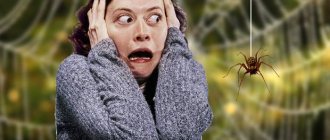For example, a person, being in a small room, feels a threat to life, danger, and is unable to expand the space and get out of here. He panics, feels suffocated, and is unable to stabilize his breathing. He begins to tremble, feel sick, his body is covered in perspiration, and his forehead is covered in cold sweat, his blood pressure rises, his heart jumps out of his chest. Agree, not the most pleasant state.
To get rid of this mental disorder, which can lead to self-destruction, you need to recognize it in time, understand the roots, and, with the help of specialists, successfully overcome it.
Description
Claustrophobia is the fear of confined spaces and cramped spaces.
Also, attacks of claustrophobia develop when being in confined places with large crowds of people, for example, on an airplane, bus, or in line at a store.
Claustrophobia and acrophobia (fear of heights) are considered the most common pathological fears. Claustrophobia is diagnosed more often in women than in men, which may be due to their high emotionality. The first attacks of increased anxiety when being in confined spaces are detected at the age of 25–35 years. After 50 years, the symptoms of claustrophobia weaken significantly and hardly bother the person. Despite this, children also develop claustrophobia, which is much more severe and has a negative impact on the child’s emotional state.
Claustrophobia in men or women can develop due to the following reasons:
- evolutionary theory. The fear of closed spaces has been preserved in humans since our ancestors. This is a kind of instinct of self-preservation, which manifests itself in an exaggerated form;
- disruption of brain activity. Inside the temporal lobe is the amygdala, which is responsible for the emergence of positive or negative emotions. If there are any changes in this area, a disruption in the normal perception of closed space may occur;
- psychological trauma, which was most often experienced in early childhood. These include difficulties during birth, when the child cannot pass normally through the birth canal. This may also be due to cases during which the baby was locked alone in a cramped room;
- features of education. If parents are too protective of their child and see danger everywhere. This can lead to the development of certain pathologies already in adulthood;
- character traits of a person. Usually these people are suspicious, indecisive, dependent, and overly impressionable.
During claustrophobia, there is a wave-like pattern, when over time the interval between attacks of anxiety and the person’s normal state becomes shorter. Without proper help from qualified professionals, there is an increase in emotional breakdowns every day.
Why are people afraid of confined spaces?
Why does a fear of enclosed spaces develop (claustrophobia, reasons):
- Genetic factor. Our distant ancestors were afraid of narrow passages and small caves, because there was a risk of collapse. It was also possible to fall into a trap if a predator entered the shelter.
- Organic brain pathologies, neurological disorders. People with claustrophobia experience abnormal brain development - a smaller right amygdala (the part responsible for emotions) and abnormal functioning of the limbic system (incorrect signals provoke the appearance of arrhythmia and shortness of breath).
- Childhood psychotrauma. Personal memories of negativity associated with small rooms can be stored at the subconscious level for a long time. Psychotrauma can have a direct and indirect path of formation. An example of direct associations: a child was locked in a dark closet for the purpose of punishment, or one day he himself accidentally slammed the door and sat locked up for a long time, he was very scared. An example of indirect associations: mom and dad quarreled and fought, the child tried to wait it out in the closet, or the parents often beat the child, and he hid from them in the closet.
- Psychotrauma in adulthood. Causes of claustrophobia in an adult: disaster, collapse, hostage-taking, road accident, etc.
- Learning from parents' experience. Some parents, for reasons of care and safety, intimidate their children, thereby creating the basis for the development of a phobia.
- Suspiciousness, suggestibility. Not only parents can intimidate, but also the media, other people, films, books. Stories about claustrophobics are a popular plot of thrillers.
This is interesting! Scientists have identified another non-standard cause of claustrophobia - a special personality type. The phobia occurs in people with a thirst for discovery, a desire to overcome conservatism and restrictions. These are powerful, active and inquisitive individuals.
Symptoms
Photo: ukstar.org
Symptoms of claustrophobia appear when a person finds himself in a small enclosed space (small room, basement, elevator). This is due not so much to the size of the room as to the person’s fear arising from the fear of a lack of oxygen in it. That is, a person suffering from claustrophobia develops panic more often when they are in rooms that are not equipped with windows. In this case, they fear that the oxygen in the room will soon run out and they will die from suffocation. In addition, an attack of claustrophobia can develop when a person spends a long time in a queue or in a large crowd of people. Therefore, you can notice that such people always try to take a place near the exit. Undergoing a diagnostic procedure such as MRI (magnetic resonance imaging) also provokes an attack of claustrophobia, so such a phobia is considered an absolute contraindication to this study.
When a person who is claustrophobic is in a confined space, adrenaline is released. As a result, a person’s blood pressure increases, a feeling of palpitations, lack of air due to respiratory distress, tremor (trembling), an increased pulse rate (tachycardia), increased sweating and dry mouth. In addition, there may be discomfort or pain in the heart area, abdominal discomfort, manifested by nausea and discomfort in the epigastric region.
When the attack is far advanced, symptoms of panic attacks appear. A person develops a fear of death, derealization (a condition in which the surrounding world is perceived as unreal or distant, in some cases accompanied by memory impairment) or depersonalization (a disorder of self-perception in which one’s own actions are perceived as if from the outside, accompanied by a feeling of inability to control them). An unstable “shaky” gait appears, and a short-term loss of consciousness is possible.
Types of violation
In psychotherapy, the following types of claustrophobia are distinguished on different grounds:
- depending on the severity of the attacks and the course of the disease - mild, moderate and severe forms;
- depending on the reasons - hereditary, primary and secondary;
- depending on the dominant fear: fear of suffocation or fear of limited space.
The main direction of treatment will depend on the type.
According to data, about 5-7% of the world's population suffers from severe claustrophobia.
Diagnostics
Photo: clinicist.ru
Determining whether a person has claustrophobia is based on identifying the symptoms characteristic of this condition. A detailed survey of the patient is carried out, the nature of his sensations and objective manifestations that arise when he is in a confined space is clarified.
It is important to be able to distinguish claustrophobia from certain individual character traits. For example, for some people, the fear of being in a cramped room in the presence of other people is associated with self-doubt, shyness, and an inferiority complex. Also, avoiding being on public transport or other crowds of people may be associated with a mental disorder. Such fear of being in the same room with other people will be associated with the patient having delusions of persecution or delusions of relation. Therefore, it is extremely important to be able to distinguish true claustrophobia from the fear of being in small rooms with crowds of people in other human conditions.
It should be borne in mind that constant fear a person experiences can lead to depressive disorder. When talking with a patient, the doctor must remember about this possibility of events, so it is recommended to treat these patients with special care so as not to miss the first symptoms of depression, thereby preventing irreversible consequences.
Prevalence
Claustrophobia is quite common.
Categories of people susceptible to attacks of fear of closed spaces:
- miners who survived imprisonment after collapses;
- submarine sailors after a submarine accident;
- former prisoners of war who survived imprisonment;
- persons serving sentences in correctional institutions where movement is limited to the territory of the prison cell.
According to statistics, every tenth man and every fifth woman on the planet are susceptible to attacks of claustrophobia.
Treatment
Photo: clinicist.ru
Treatment of claustrophobia is a long process that requires a lot of patience from the patient. First of all, psychotherapists work with people suffering from claustrophobia, who, in addition to their classes, can prescribe medications that reduce anxiety.
Psychotherapy is carried out both individually and in group form. The choice depends on the severity of the disorder and the person’s personality. It is believed that individual sessions are the most effective, allowing to build a trusting relationship between the patient and the doctor, which leads to the accelerated achievement of the desired effect.
The psychotherapist is aimed at finding the cause of claustrophobia. Research has shown that a common cause is psychological trauma experienced in childhood. Some parents punish their children by locking them in dark spaces, such as small dark rooms. Unfortunately, such rash actions of parents can lead to serious consequences, including the development of claustrophobia in the child. After identifying the problem, the specialist teaches the patient to cope with his condition. For this, breathing techniques, muscle relaxation, and various other techniques are used. There is a technique in which a person, under the supervision of a psychotherapist, is immersed in conditions that provoke a phobia. For this purpose, various enclosed spaces, elevator cabins, and vehicles can be used. At the same time, the psychotherapist helps you realize your fear and stop being afraid of it.
Treatment of claustrophobia through hypnosis has a good effect. A psychotherapist puts a person suffering from claustrophobia into a state of hypnotic sleep, which promotes maximum relaxation and calm. Then the doctor establishes the reason for the development of this phobia and instills in the patient information, thanks to which he completely forgets about his fears, while self-confidence is strengthened. In addition, thanks to hypnosis, you can gradually teach a person to cope with his condition, including stopping the appearance of new attacks of claustrophobia.
Drug treatment is aimed at reducing anxiety. Anxiolytics (tranquilizers) are used for this purpose. They significantly reduce the manifestation of vegetative symptoms and reduce the frequency of attacks. Almost all patients suffering from claustrophobia are prescribed antidepressants, which are taken for a long time (3-6 months).
Emergency help for claustrophobia
The first attack of claustrophobia occurs unexpectedly, it can occur at any time and in any place, for example, while undergoing an MRI or while flying on an airplane, while riding in an elevator. What to do then?
Taking an MRI
If a person is aware of a phobia, then they need to inform the operator conducting the diagnosis. Then he will give you earplugs and a blindfold. This will help you abstract from the sounds and conditions of the examination. Additionally, the client must abstract himself, for example, mentally read poetry or keep count. In advanced stages of the disease, it is permissible to administer a sedative before the examination. There are cases when the patient was put under anesthesia and examined using a special open-type apparatus.
Fear of airplanes and elevators
What to do if you have a fear of elevators and claustrophobia on an airplane? First aid during panic with a phobia of fear of elevators and airplanes:
- Imagine that you are outside an enclosed space, for example, on a staircase or on the street. When flying on an airplane, imagine landing and the views that await you in a new city.
- Count to fifty and repeat to yourself “everything will be fine”, “I won’t die”, “I’ve done this more than once”, etc.
- Contact the flight attendant. They are trained to provide first aid to people with phobias and in times of panic.
Medicines
Photo: zena.cz
For claustrophobia, courses of taking tranquilizers are prescribed. These drugs have the following effects:
- anti-anxiety (their main effect is to reduce anxiety, fear, restlessness, and eliminate obsessive thoughts);
- vegetostabilizing (consists of reducing vegetative manifestations of anxiety (tachycardia, increased blood pressure, increased sweating, gastrointestinal disorders));
- sedative (calming effect, which, unfortunately, is accompanied by decreased concentration and lethargy);
- muscle relaxant (relaxes the muscles, which is accompanied by a feeling of general weakness and lethargy);
- sleeping pills (accelerates the onset of sleep, increases the depth and duration of sleep).
These drugs are prescribed by a doctor in a course of 2–3 weeks of continuous use. Long-term use of benzodiazepine tranquilizers is not recommended, as dependence may develop. Therefore, if a person still needs to take these drugs for a long time, after the course, they should stop taking the drugs for a while, and then repeat the next course of use. In addition, withdrawal syndrome, which can develop during abrupt withdrawal of tranquilizers, is prevented by gradually reducing the dose and increasing the interval between doses. Contraindications to the prescription of tranquilizers are: liver and respiratory failure, ataxia, glaucoma, myasthenia gravis. Side effects that occur while taking tranquilizers include: drowsiness, general weakness, lethargy, decreased concentration and short-term memory, decreased blood pressure, constipation, nausea, urinary retention or incontinence. Considering all the nuances of these drugs, it is necessary to strictly follow all doctor’s prescriptions.
Antidepressants are prescribed to improve a person's mood and general mental state. The development of the expected effect does not occur immediately after starting to take the drugs, but after approximately 10 days. This is explained by the fact that the development of the antidepressant effect is associated with the accumulation of neurotransmitters in the area of nerve endings and with the slow development of adaptation mechanisms in the circulation of neurotransmitters. As a result, antidepressants are prescribed in a course of continuous use for 3–6 months, during which time the desired effect is gradually achieved.
How to cure a phobia with medication
Several groups of drugs are used in drug therapy:
- Tranquilizers (Gidazepam). They have a psychosedative effect on areas of the central nervous system, have a pronounced calming effect, and relax the skeletal muscles. The downside is that they are addictive and require specialist prescriptions.
- Antidepressants of the tricycline category (Imipramine) prevent the reverse release of adrenaline by nerve channels, stabilize the psyche, and prevent the breakdown of serotonin (the good mood hormone). After taking them, the activation of fears and depression decreases. The effect is replaced after 6–7 days.
- In the treatment of claustrophobia, beta-blockers (Atenolol) are used. Medicines reduce the sensitivity of receptors to adrenaline, reducing the manifestation of panic fear, stabilizing heart function.
Folk remedies
Photo: glaznoy-doctor.ru
A person suffering from claustrophobia can independently learn various methods of relaxation, which are indispensable when acute attacks of phobia suddenly occur. If you feel an attack approaching and understand that it is impossible to avoid it, it is recommended to try to relax as much as possible. You should concentrate your gaze on a specific object that is at eye level. You should not frantically look around in search of a way out, as this increases panic and contributes to the growth of fear. It is also important to breathe properly, inhaling air deeply through your nose.
There are physical exercises that promote muscle relaxation. The Jacobson method of muscle relaxation is considered the most popular at the moment. The exercises are designed in such a way that during their implementation, alternating states of tension and relaxation of individual muscle groups occur. The author of this technique, while conducting research on human emotions, discovered a direct connection between a person’s emotional state and muscle tension. Based on this, a theory was put forward that muscle relaxation helps relieve nervous tension and stabilize a person’s emotional background. The exercises proposed by the author are quite simple, so anyone interested in this technique can easily study the list of exercises in a fairly short time. In a stressful situation, using this relaxation method helps to calm down, relieve neuromuscular tension and gain control over your emotions, which is especially important for people with a phobia.
To stabilize your mood, you can use various herbal decoctions that have a calming effect. The following herbs have this property: peppermint, lemon balm, valerian, chamomile, St. John's wort and many others. You can purchase a ready-made collection of herbs at the pharmacy or prepare your own tea at home using any of the listed herbs that have a calming effect. These teas not only improve your mood, but also normalize sleep, reduce irritability and nervousness, relieve fatigue and increase performance.
The information is for reference only and is not a guide to action. Do not self-medicate. At the first symptoms of the disease, consult a doctor.
conclusions
The person is afraid. Fear guides his actions and thoughts. Is it really impossible to overcome this? Will fear always be the main thing? Will you always have to listen only to him and his cruelty? But no! We must fight! Even if it is black, even if it is viscous, even if it is huge, even if it is very, very strong... But this is just a feeling, just an emotion. And a person can always become stronger, the main thing is to believe in yourself and know that victory will lead to a completely different life, where everything will be different: joyful, bright, reliable. Remember what the ancient sage Seneca said? To understand that not everything is so scary, you just need to take the first step. A person must find the strength within himself and take this first step, and then another, and then another and another. And these steps will lead to victory: to victory over fear, and to victory over oneself, and then to more and more victories. So take your first step.
Disease prevention
As with other nervous disorders, bad habits such as alcohol, smoking and even drinking coffee in large quantities are unacceptable for people suffering from phobias and fearing attacks.
The best help in successfully curing claustrophobia is following the principles of a healthy lifestyle and increasing stress resistance. Sports and regular walks in the fresh air, as well as calming breathing practices, creativity and meditation will help strengthen the nervous system.
The occurrence of phobias itself is directly related to the patient’s general anxiety. And the lower the level of anxiety, the easier and less often manifestations of acute fear will occur.
Symptoms
Gambling addiction - is it a disease or not?
Symptoms of claustrophobia include:
- Feeling of blood pulsating in the temples when a person is forced to be in a confined space;
- Increased heart rate;
- Difficulty breathing, shortness of breath;
- Attacks of dry cough;
- Nausea, vomiting;
- Heaviness in the arms and legs;
- Fainting.
Important! The description of the symptoms of claustrophobia can only be observed in situations of stress. If a person is in a spacious room, in a familiar environment, then he looks completely healthy and feels comfortable.











